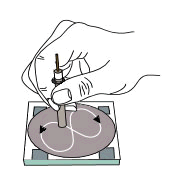  |
  |
| With repeated electrochemical redox reaction experiments, the adhesion of the experimental products on to the electrode surface, and the electron transfer rate is attenuated gradually. If the electron transfer speed becomes slow, the difference between peak potentials for oxidation and reduction will broaden. |  |
Refreshing the electrode surface by polishing, the electron transfer rate will increase again. Consequently, the peak potential difference becomes narrow and returns to an ideal CV. Electrode: Glassy carbon electrode |
| Catalogue No. | Description |
| 013223 | PK-3 Electrode Polishing kit |
| Contents | |
| 012620 | 0.05 µm polishing alumina (20 mL) |
| 012621 | 1 µm polishing diamond (10 mL) |
| - | Alumina polishing pad (10 pcs) |
| - | Diamond polishing pad (10 pcs) |
| 013222 | Replacement glass plate for PK-3 (1 pc) |
| Polishing pad for acquisition separately | |
| 012600 | Alumina polishing pad (20 pcs) |
| 012601 | Diamond polishing pad (20 pcs) |
| Catalogue No. | Description | Quantity | purpose |
| 012620 | 0.05 µm polishing alumina (20 mL) | 1 | For final polishing |
| 012621 | 1 µm polishing diamond (10 mL) | 1 | For intermediate polishing |
| 013234 | 6 µm polishing diamond (10mL) | 1 | For intermediate polishing |
| 012600 | Alumina polishing pad (20 pcs) | 1 | For final polishing |
| 012601 | Diamond polishing pad (20 pcs) | 1 | For intermediate polishing |
| 012610 | Coarse polishing Pad (20 pcs) | 1 | rough hewn |
| 012611 | Emery paper UF800 (20 pcs) | 1 | For PG and PFCE electrodes |
∗Do not use the polishing solution to the rough hewn polishing pad.
∗For polishing using emery paper, use only distilled water.
∗Polishing solution can not be used for the PG and PFCE electrodes.


Attention: Polishing with PK-3 is the most appropriate way to clean up electrode surface. Please consult us when other methods are applied.Please, don't use poor quality alumina, as it is not enough efficient for polishing.
For the electrodes listed below,
| Catalog No. | Description | Isolation | OD | ID |
| 002252 | PGBE Pyrolytic Graphite Electrode (Basal Plane) | PEEK | 6 mm | 3 mm |
| 002253 | PGEE Pyrolytic Graphite Electrode (Edge Plane) | PEEK | 6 mm | 3 mm |
| 002408 | PFCE 3 Carbon electrode | PEEK | 6 mm | 3 mm |
| 002409 | PFCE 1 Carbon electrode | PEEK | 6 mm | 1 mm |
| 011854 | SPFCE Carbon electrode | PEEK | 3 mm | 1 mm |
∗For the PGBE electrode (Cat. No. 002252), because of the material characteristics, it is difficult to keep the perfect basal surface. For the precise PGBE basal surface treatment evaluation, you can have the publications below as a reference.
The assessment of the basal and edge surface is done by measuring the Raman spectra. This method is reported in the last two publications mentioned above.
∗notice
Do not polish with a finer grade of emery paper ( #6000 etc.). PFCE electrode does not need mirror finishing like a GC electrode.